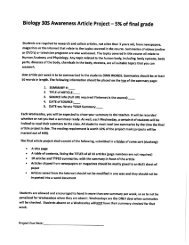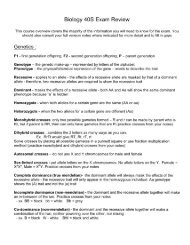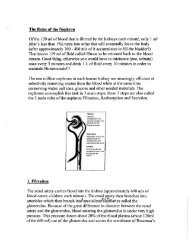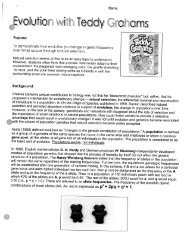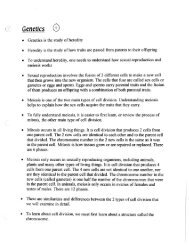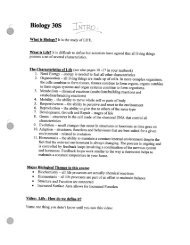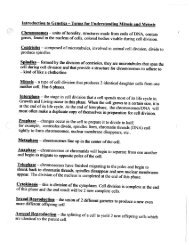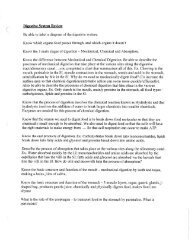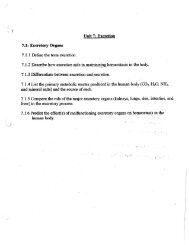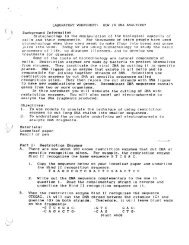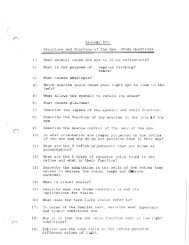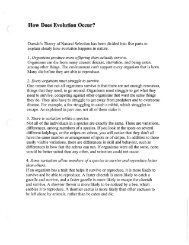DNA fingerprinting: a detective story - Mrs Stovel
DNA fingerprinting: a detective story - Mrs Stovel
DNA fingerprinting: a detective story - Mrs Stovel
You also want an ePaper? Increase the reach of your titles
YUMPU automatically turns print PDFs into web optimized ePapers that Google loves.
SSR. Dee 1995, %,' (279)<strong>DNA</strong> <strong>fingerprinting</strong><strong>DNA</strong> <strong>fingerprinting</strong>:a <strong>detective</strong> <strong>story</strong>soElizabeth BumsNotes on <strong>DNA</strong> <strong>fingerprinting</strong> provide a useful revision of genetic structure and its application.A practical exercise also allows students to understand and apply results from <strong>DNA</strong><strong>fingerprinting</strong>.<strong>DNA</strong> FINGERPRINTING : A DETECTFigure IiNTRODUCnONMost A-level biologists have heard of <strong>DNA</strong><strong>fingerprinting</strong> from the media and yet probablyknow little more than the general public.<strong>DNA</strong> <strong>fingerprinting</strong> is a clear exampleof biology in practise, which has been wellintegrated into society to solve crimes andresolvepaternity disputes. Despite the technique'swide use, general biology texts rarelyaddress <strong>DNA</strong> <strong>fingerprinting</strong>.Actually carrying out <strong>DNA</strong> <strong>fingerprinting</strong>is expensive, technically demandingand involves the use of potentially hazardoushuman tissue. It is not really practicablein a school. However a talk and practicalexercise on <strong>DNA</strong> <strong>fingerprinting</strong> can providea useful revision of <strong>DNA</strong> structure andits application. The exercise also allowsstudents to appreciate gel electrophoresis,restriction enzymes, probes, 'junk' <strong>DNA</strong>and genetic variation.SETTING THIF SCENEImagine, a young lady has been murderedand no witnesses have been found. Thepolice have identified three possible suspects,none of whom confess. Fortunately,forensic scientists can discover who is tellingthe truth.Figure 2AThe suspectsFragments of blood, skin and hair believedto belong to the murderer are isolatedat the scene of the crime. All of thesefragments contain cells. It is the <strong>DNA</strong>within these cells which is unique to a person.<strong>DNA</strong> contains functional genes, calledexons, which code for the body's proteins.These exons only occupy 10% of a humangenome. In between exons are introns, alsocalled 'junk' <strong>DNA</strong> since it appears to be29
<strong>DNA</strong> Ear` er ,rias€tELtABILCTY OF <strong>DNA</strong> EF_NCERPRINTINC ASEVIDENCESince <strong>DNA</strong> <strong>fingerprinting</strong> can be used asincriminating evidence many people havedoubted its reliability. The probability of 4bands matching by chance between 2_ peopleis an unreliable I out of 250 . However,if the <strong>DNA</strong> fingerprint of a murderer andsuspect containing 20 bands match , you canbe sure it is not just luck. The odds of sucha chance match is 1000,000 ,000,000 to Iwhich is much larger than the population ofthe world.SSTi, Dec 1995,Case Study 3In this situation a mother did not knowwhich of two men was the real father (Fl orP2) to her child (Cl). <strong>DNA</strong> <strong>fingerprinting</strong>tests can be used to resolve the matter sincehalf of the genetic material of the child ispassed on from the mother and half fromthe father. The child will therefore share halfof the bands in its <strong>DNA</strong> fingerprint with themother and half with its biological father.APPLICATIONS OF <strong>DNA</strong> FINGERPRINTINGCase Study IThe use of <strong>DNA</strong> <strong>fingerprinting</strong> to solvecrimes has already been discussed. Findout which of these suspects <strong>DNA</strong> fingerprintmatches the bloodstains and is thereforeguilty.F11.4\I\FaF£s4=11$II I I I 11Figure 15IMME fill 1 M I I ISri ii it lei►111 411119 1 11 1^^/r 1 f 1 tl1^i1^11^ n s ti-^ 1 n i1 P 111Eamon 1 1 1Case Study I - a criminal investigationwho is guilty?Case Study 2Which of these twins are genetically identical?T-- ;.aimFigure 16110111111111111111911111pie11mm lit I I I 1 1a t 1i1* t1 l i eCa.,w Study 2 - an identical twini,lvo:01ga o f StnWhich (if thvw twins are geneticallytdt titvc:tl3^ II1Figure 17Case Study 3 -a paternity disputewhich is the real father?Case Study 4A mother (M) wishes to confirm which ofher children (C1-C4) are fathered by herhusband (F) (Figure 18).Case Study 5A complicated family dispute can be resolvedusing <strong>DNA</strong> <strong>fingerprinting</strong>. Firstly,which of the children (C1-C4) biologicallybelong to the mother (M)? Therefore, whois the father (F1 or F2)?The value of <strong>DNA</strong> <strong>fingerprinting</strong> in forensicscience and paternity disputes cannotbe debated . However, <strong>DNA</strong> <strong>fingerprinting</strong>is a wide ranging tool for many
SSR, Dec 1995, 77 (2 79;<strong>DNA</strong> <strong>fingerprinting</strong>1 C1 C2 C3 C4F1+1 C1 Q C3 C4 Fi F2rMso40 M - awink -«^...- - s t^IMti s ......-2 1"1liiiFigureiSCaseStudy4 -a paternaldispute. Whichofthe mother's children are fathered by F?Figure 19Case Stetly 5 - a family disputeWhich children biologically belon to themother? Therefore, who are the children'sfather, Fl or F2?other biologists. For example, evolutionarytrees and migratory patterns have beentraced using the simple principle that theAnswersCase Study 1Case Study 2Case Study 3Case Study 4Case Study 5EBurns is in hiproject is spon,prostate cancerctimore similar the <strong>DNA</strong> fingerprints are, themore likely they are to have shared a recentcommon ancestor."oiogy degree. Her third yearetic changes associated with35
<strong>DNA</strong> Frn_ernr = n.ting CASE STUDY Questions1. Who is guilty`? Is it suspect (1,2,3,4,5,6, or 7) ?2. Which set of twins are identicle (set 1 or set 2) ?3. Who is the real father (F I or F2) ?4. Which children belong to the father ( C 1, C2, C3 or C4) ?Answer:5. Which children belong to father # I (F 1) and which childrenbelong to father #2 (F2) - (C 1, C2, C3 or C4) ?F1F2



